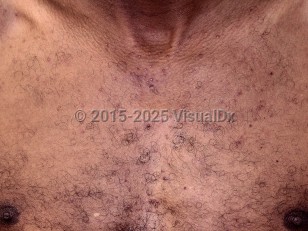The most common mucocutaneous adverse events associated with EGFR inhibitors include papulopustular (acneiform) eruptions, xerosis and eczematous dermatitis, fissuring of the hands / feet, hair changes, nail changes including paronychia, and mucositis.
The papulopustular (acneiform) drug eruption is the most common of all EGFR inhibitor-induced dermatologic adverse events.
Acneiform eruptions are seen in more than 50% of patients treated with EGFR inhibitors, but the incidence and severity vary with the type of drug used. Interestingly, there is a positive association between the presence and degree of acneiform eruption and response rate of cancers to EGFR inhibition.
Onset of the acneiform eruption is within the first 2 weeks of initiation of treatment (range 3-182 days) and usually resolves within 4 weeks of discontinuation of EGFR inhibitor therapy.
The eruption typically appears on the face, scalp, and upper trunk and may be associated with pain, burning, pruritus, and dysesthesias.
Increased incidence and severity of acneiform eruptions have been associated with higher doses of the drug and sun exposure (ultraviolet [UV] radiation). Staphylococcal superinfection can occur.
Four distinct clinical phases of evolution of the acneiform eruption may be noted:
- Week 1 – sensory disturbance (erythema, edema, and dysesthesias)
- Weeks 1-3 – appearance of papulopustular eruption
- Weeks 3-4 – crusting (drying of purulent material)
- After 4 weeks – residual erythema, telangiectasias, and xerosis
- Grade 1 – Asymptomatic.
- Grade 2 – Associated with psychosocial impact; oral antibiotics or steroid indicated; local intervention indicated (eg, topical antibiotic, antifungal, or antiviral); limiting instrumental activities of daily living (ADL).
- Grade 3 – Severe symptoms; intravenous (IV) antibiotic or steroid indicated; limiting self-care ADL.
- Grade 4 – Life-threatening consequences.
- Grade 5 – Death.
EGFR inhibitors are also associated with severe xerosis and asteatotic dermatitis, with diffuse scaling and associated pruritus. Painful fissures can also occur on the fingers and feet. EGFR-inhibitor-associated xerosis usually occurs within the first 2 months of therapy, often co-occurring with or succeeding the acneiform rash.
Increased photosensitivity can be observed in patients being treated with EGFR inhibitors. Cases of drug-induced subacute cutaneous lupus erythematosus (SCLE) have also been reported.
Nail and hair changes are frequent among patients treated with EGFR inhibitors. Nail changes occur after several weeks to months of therapy and include painful paronychia with swelling of the nail folds as well as the development of periungual granulation tissue along the lateral nail plate (also known as pyogenic granuloma-like lesions). These nail toxicities can be quite painful and limit everyday activities.
As per the NCI-CTCAE v6, grading scale:
- Grade 1 – Nail fold edema or erythema; disruption of the cuticle.
- Grade 2 – Local intervention indicated; oral intervention indicated (eg, antibiotic, antifungal, antiviral); nail fold edema or erythema with pain; associated with discharge or nail plate separation; limiting instrumental ADL.
- Grade 3 – Operative intervention indicated; IV antibiotics indicated; limiting self-care ADL.
The stomatitis and mucositis experienced by patients treated with EGFR inhibitors is characterized by aphthous-like ulcerations, mucosal erythema, and erosions that primarily affect the nonkeratinized oral mucosa. Onset is typically within the first few weeks of therapy and is usually mild-to-moderate in severity. Occasionally, mucositis can also involve the genital mucosa, leading to vulvovaginitis and balanitis.
It is important to note that patients who are treated with the bispecific monoclonal antibody amivantamab, which targets both EGFR and mesenchymal epithelial transition factor (MET), can experience particularly severe cutaneous manifestations. In addition to the presentations detailed above with other EGFR inhibitors, patients may present with thick, crusted, purulent lesions on the scalp that resemble severe erosive pustular dermatosis, as well as inguinal, genital, and intertriginous ulcerations.



